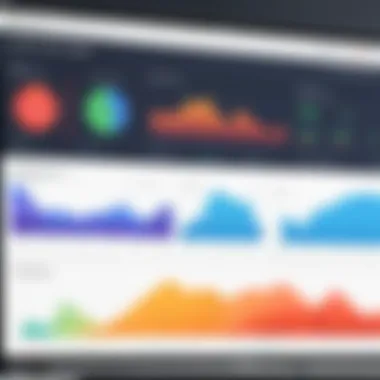Understanding Commercial Cleaning Bidding Software


Intro
In the commercial cleaning sector, efficiency and accuracy in bidding processes are paramount. As cleaning firms strive to maximize their profitability while streamlining their operations, commercial cleaning bidding software emerges as an essential tool. This software platform enables users to generate precise bids, manage client relationships, and ensure compliance with industry standards. Understanding this software is crucial for decision-makers in the cleaning industry who wish to enhance their operational capabilities and secure a competitive edge.
The use of bidding software addresses both the challenges and opportunities present in a dynamic market. Organizations can benefit from improved data management and faster response times to client inquiries. By automating the bidding process, companies can significantly reduce manual errors, allowing for more accurate quotes and enhancing overall customer satisfaction.
In the sections that follow, we will explore the key features and functionalities, pricing models, and other relevant considerations that enable effective utilization of commercial cleaning bidding software.
Prelims to Commercial Cleaning Bidding Software
Commercial cleaning bidding software has emerged as a pivotal resource for organizations in the cleaning industry. The implementation of these systems can significantly enhance efficiency and accuracy in the bidding process. In today's competitive landscape, businesses seek tools that provide a clear advantage when responding to tenders and offers. This section introduces the core concepts of commercial cleaning bidding software, its relevance, and its importance to facilitate informed decisions.
Definition and Purpose
Commercial cleaning bidding software refers to specialized applications designed to streamline the process of preparing, submitting, and managing bids for cleaning contracts. The primary purpose is to automate aspects of bidding that would otherwise require substantial time and manual effort. These tools help enhance the quality of proposals, ensuring that they meet necessary specifications and are competitive in terms of pricing. By automating calculations and providing templates, businesses can eliminate common errors and expedite submissions.
In summary, these platforms simplify the bidding lifecycle, from initial contact to finalized agreements. They provide a structured way to manage bids, track changes, and ensure compliance with various regulations or client specifications. This ultimately leads to a faster turnaround time for proposals and a more organized approach to winning contracts.
The Importance for Cleaning Businesses
Understanding the significance of commercial cleaning bidding software is essential for businesses aiming for optimal performance in their bidding strategies. This software is not merely an addition to a company's toolkit; it is often the backbone of effective bid management.
Several factors underscore its importance:
- Time Efficiency: Bidding can be a labor-intensive process. Software can cut down the time needed to prepare bids. This allows staff to focus on service delivery and other core business activities.
- Cost-effective Solutions: Accurate pricing is crucial. Commercial cleaning bidding software helps in assessing costs more effectively, ensuring bids are both competitive and profitable.
- Increased Accuracy: These tools minimize the risk of human error. Automated calculations ensure that prices reflect all necessary components, from labor to materials.
- Enhanced Communication: Many bidding platforms come with features for real-time collaboration. This allows team members to work together on proposals, improving the quality of submissions.
"Investing in commercial cleaning bidding software can transform not just how bids are created but can significantly impact win rates and overall business growth."
Key Features of Commercial Cleaning Bidding Software
Understanding the key features of commercial cleaning bidding software is paramount. The right software can drastically influence the efficiency, accuracy, and overall success of a bidding process. Organizations in the cleaning industry need to carefully assess these features to select software that not only meets their immediate needs but also positions them for future growth. Below, we explore various essential aspects of effective bidding software.
User-Friendly Interface
A user-friendly interface is crucial when it comes to commercial cleaning bidding software. If the software is complex or difficult to navigate, it can frustrate users and decrease overall productivity. Users, whether they are managers or field staff, should find it simple to input information, generate bids, and access important documentation.
An effective interface minimizes the learning curve, allowing firms to maximize software investment from the get-go. Thus, decision-makers should prioritize tools that feature intuitive navigation, clear labeling, and visually appealing layouts. This approach helps the team become proficient quickly, ensuring a smooth transition into new systems.
Automated Bidding Process
The automated bidding process is another essential feature that can save time and effort. Traditional bidding methods often require significant manual work, which can lead to errors. Automation streamlines this process, allowing for quick calculations and generation of bids based on predefined templates.
With automated processes, companies can also easily adapt to fluctuating market demands and respond rapidly to requests. This level of agility is crucial in today’s fast-paced environment. A more automated bidding process translates directly to increased capacity for handling high volumes of bids without sacrificing quality.
Customizable Templates
Customizable templates are vital as they facilitate a firm’s ability to tailor bids according to specific client needs or projects. Having pre-built templates ensures that companies can maintain a level of consistency while also integrating necessary customization to stand out.
These templates should allow users to adjust elements such as pricing structures, terms and conditions, and service descriptions. The flexibility these templates provide can position a business to better meet the expectations of prospective clients. Also, it fosters a professional image that can enhance credibility in competitive scenarios.
Real-Time Collaboration Tools
Real-time collaboration tools enhance communication and teamwork. Cleaning businesses often operate with various stakeholders involved in the bidding process, from sales teams and project managers to clients themselves. Integrated communication features enable team members to work concurrently on bids, share feedback instantly, and make prompts adjustment where necessary.
For example, if a client requests a change in service scope, teams can update the bid while maintaining all members in the loop. This fosters a cohesive working environment that allows the organization to respond quickly to changes in client needs, ultimately improving client satisfaction and retention.


"Effective collaboration can be the differentiating factor in securing a bid, making the tools that support it invaluable for cleaning businesses."
In summary, the key features of commercial cleaning bidding software represent a blend of usability, automation, flexibility, and collaboration. Selecting software equipped with these attributes helps cleaning organizations enhance their bidding strategy and overall operational efficiency.
Benefits of Implementing Bidding Software
The implementation of commercial cleaning bidding software offers numerous advantages that can significantly impact a cleaning business's operations. This section explores the benefits that arise from adopting such software, essential for decision-makers considering new technology solutions. Understanding these benefits can aid business owners in enhancing efficiency and improving competitiveness in the market.
Increased Efficiency in Estimates
One primary benefit of bidding software is the increased efficiency in generating estimates. Traditional methods often involve manual calculations and lengthy evaluation processes. With software solutions, estimates can be created swiftly by automating data entry and calculation processes. The software typically allows businesses to input their costs and pricing structures and then generates accurate bids based on this data. This automation reduces the time spent on preparing bids, allowing businesses to focus on other areas of their operations. Additionally, the consistency in estimates reduces the risk of human error, fostering trust with clients.
Improved Accuracy in Pricing
Another significant advantage of utilizing bidding software is the improvement in pricing accuracy. Incorrect pricing can lead to financial losses or the inability to secure contracts. Software like Jobber aids in maintaining accurate records of service prices, overhead costs, and profit margins. This way, users can produce bids that reflect the true cost of service while ensuring competitive pricing. As a result, businesses can minimize discrepancies in their bids, aligning expectations between clients and service providers more effectively.
Enhanced Competitive Advantage
In today's competitive landscape, businesses must differentiate themselves. Implementing bidding software can provide a distinct competitive edge. Organizations that leverage technology tend to respond quicker to client requests, enabling them to submit bids faster than their competitors. Speedy responses can lead to more successful contracts. Furthermore, software often provides analytics features that allow businesses to assess past bids and performance. Understanding what worked and what did not can help refine future strategies, establishing a long-term competitive advantage.
Streamlined Workflow Processes
Lastly, commercial cleaning bidding software contributes to streamlined workflow processes. The software often integrates various business functions, such as scheduling, billing, and project management, into one platform. This integration enhances collaboration among teams and eliminates delays related to inter-departmental communication. Employees can access real-time information about bids, client interactions, and job statuses, reducing the time spent searching for data across multiple systems. Streamlining processes not only saves time but also enhances overall productivity, allowing businesses to manage more contracts and serve their clients better.
"The right bidding software can change how cleaning businesses operate, leading to improved outcomes and customer satisfaction."
In summary, the implementation of commercial cleaning bidding software offers increased efficiency, improved precision in pricing, a competitive edge, and streamlined operations. These factors combine to position cleaning businesses more favorably within the market, ultimately driving growth and profitability.
Market Landscape of Bidding Software
Understanding the market landscape of bidding software is crucial for anyone involved in the commercial cleaning industry. This segment not only outlines the current dynamics but also highlights how different solutions cater to diverse business needs. Knowing the landscape allows organizations to identify opportunities, foresee potential challenges, and choose the software that fits best.
Current Trends in the Industry
The commercial cleaning sector has witnessed several notable trends that shape bidding software. First, cloud technology is becoming more prevalent, allowing users to access software from any location. This flexibility supports remote work models, which are increasingly common today. Additionally, the utilization of data analytics within these solutions has grown. Cleaning companies are using analytics to better understand their operations and improve decision-making processes.
Another trend is the rise of integration capabilities. Businesses are looking for bidding software that can seamlessly connect with their current management systems. An integrated approach enables smoother workflows and reduces redundancy in tasks. Moreover, mobile solutions are gaining traction. With mobile applications, personnel can create bids on the go, further enhancing efficiency.
Furthermore, the focus on user experience (UX) is more pronounced. Software providers are prioritizing intuitive interfaces that require minimal training. This helps in quick adoption among teams, leading to faster returns on investment. Lastly, an emphasis on sustainability is rising. More software solutions are now promoting eco-friendly practices, aligning with a broader commitment to corporate social responsibility.
Key Players and Solutions
In the landscape of commercial cleaning bidding software, several key players have established themselves as leaders. Companies like Janus Cleaning Solutions and CleanBid offer robust platforms known for their reliability and user-friendly functionalities. These solutions give users advanced features for managing bids while ensuring ease of use.
Another significant player is QBS, Inc., which provides comprehensive solutions focused on improving client relationships through smart bidding tools. Their systems integrate CRM with bidding, allowing for more strategic engagement with potential clients.
BiddingOwl has also carved out a niche by catering to smaller cleaning companies. Their model focuses on affordability without sacrificing essential features, allowing startups to compete effectively in a crowded market.
It is essential to assess these platforms critically. Each solution presents unique advantages, depending on the specific use cases and client needs. Organizations should explore key aspects such as cost, scalability, and customer support when comparative analyzing options.
"Selecting the right bidding software should center around identifying a provider that aligns with your operational goals and business size."
Evaluating Bidding Software Options
Evaluating bidding software options is crucial for any organization in the commercial cleaning industry. The right software can significantly influence how effectively a company operates. Therefore, choosing the right tools based on specific needs should be a priority. This process demands a keen understanding of what features are essential, as well as how they align with the business's operational goals. In addition, proper evaluation helps ensure that the software selected produces the best outcomes, optimizing both time and resources.


When looking at bidding software, important considerations include usability, cost, functionalities, and the support offered by the vendor. The following sections will explore in-depth criteria for effective evaluation and ways to leverage user reviews and testimonials for informed decision-making.
Criteria for Effective Evaluation
When evaluating bidding software options, focusing on the following criteria can help streamline the process:
- Usability: The software should have an intuitive interface. A user-friendly design enables staff to get up to speed quickly, minimizing training time and increasing productivity.
- Features and Functionalities: Look for essential features like automated bidding, customizable templates, and real-time collaboration tools. Assess which functions meet the specific needs of your organization.
- Integration: The selected software must integrate smoothly with existing systems used within the business. This ensures a cohesive workflow and reduces the risk of disruptions.
- Customer Support: Strong support from the software provider can make a significant difference during implementation. Ensure that they offer timely assistance and comprehensive resources.
- Scalability: As businesses grow, their needs change. Bidding software should be able to scale to handle increased demands without requiring a complete overhaul or replacement.
Every point above plays a vital role in forming a comprehensive assessment of the available software, allowing businesses to make choices that last.
User Reviews and Testimonials
Feedback from current or previous users is indispensable when evaluating bidding software. User reviews often provide insights not found in promotional materials from the vendors. Here are reasons why reviews and testimonials matter:
- Real-Life Experiences: Users can share how the software performed in various scenarios. They often discuss both strengths and weaknesses, which helps companies understand potential issues before committing.
- Common Issues: Recognizing common challenges faced by other users can alert your organization to problems you may encounter, allowing you to prepare solutions in advance.
- Comparative Insight: Reviews frequently compare different software solutions. By looking at second-hand experiences, you can identify which tools are more effective for specific applications.
"A software choice should not only be based on features but also on how well it serves those features in real-world applications."
- Boosting Trust: Positive testimonials from credible sources can enhance confidence in a particular solution. When peers in the industry endorse software, it signals a level of reliability and performance.
In summary, evaluating bidding software options is essential to making informed decisions. By considering criteria that matter and leveraging user feedback, organizations can better navigate the software landscape and implement solutions that genuinely enhance operations.
Challenges Faced in the Implementation of Bidding Software
Implementing bidding software in the commercial cleaning sector brings about various challenges. Understanding these obstacles is essential for decision-makers and IT professionals, as it can greatly impact the successful adoption of such a system. Addressing these challenges necessitates a structured approach, blending technical solutions with organizational strategies.
Integration with Existing Systems
When adopting new bidding software, one immediate challenge is the integration with existing systems. Many cleaning companies already utilize software solutions for various functions such as scheduling, accounting, or customer relationship management.
The difficulty arises in ensuring that the new bidding system can communicate and work effectively with these pre-existing systems. This integration is vital for maintaining the flow of information, avoiding data silos, and ensuring that workflows remain uninterrupted. If the systems do not integrate well, it can lead to excessive manual entry of data. This not only wastes time but can also introduce errors, undermining the benefits of automation.
Key considerations for successful integration include:
- Compatibility: Check if the new software can operate with your current systems or will require additional software layers.
- API Availability: Seek out bidding solutions with robust API support, allowing for better data interchange.
- Vendor Support: Ensure that the software vendor provides adequate resources for integration.
Integrating systems correctly can streamline processes, remove redundancies, and ultimately enhance efficiency.
Staff Training Requirements
Another significant challenge is the requirement for staff training. New bidding software may offer advanced features, but if employees do not understand how to use these tools, the implementation will not reach its potential.
Training is crucial for multiple reasons. First, it helps to ensure that staff can navigate the system proficiently, minimizing mistakes that could occur due to lack of knowledge. Second, effective training fosters a culture of technology acceptance. When staff feel confident in using the new system, they are more likely to embrace it and adapt to the changes in workflow.
However, training programs can demand considerable time and resources. Here are important aspects to consider in this area:
- Training Schedule: Develop a comprehensive schedule that fits into the daily operations of the staff without causing major disruptions.
- Learning Materials: Provide manuals, tutorials, or access to online training resources for staff to reference as they learn.
- Ongoing Support: Implement a support system for questions or clarifications as employees familiarize themselves with the new software.
Training should not be viewed as a one-off activity but rather as an ongoing process that evolves as the software itself is updated.
"Effective integration and training not only enhance the utility of bidding software but also secure a smoother transition for all stakeholders involved."
Understanding these challenges helps leaders in the cleaning industry make more informed choices when selecting and implementing bidding software.
Case Studies of Successful Implementations


The analysis of case studies provides significant understanding when it comes to the implementation of commercial cleaning bidding software. These real-world examples illustrate the challenges, strategies, and successful outcomes that businesses experience. By examining these scenarios, decision-makers in cleaning companies can fortify their knowledge regarding best practices. Moreover, they can learn from both successes and mistakes of other businesses, which is essential for informed decision-making.
Small Business Success Stories
Small businesses often face unique challenges that differ from larger entities. Their limited resources make efficiency vital. Many small cleaning companies have successfully adopted bidding software, leading to notable improvements.
For instance, a local cleaning service, which previously relied on manual methods for bidding, adopted CleanBid Pro. The transition enabled them to streamline their quoting process significantly. Before using the software, they spent hours generating quotes. After implementation, they reported reducing the time spent on this task by over 50%.
The software's user-friendly interface provided essential templates that matched their needs, allowing them to respond to requests swiftly. This speedier process not only improved business efficiency but also increased customer satisfaction. Potential clients appreciated the prompt responses, which led to a higher conversion rate for new contracts.
In another example, a small business in the healthcare cleaning sector utilized BidBetter. The software facilitated collaboration among team members, allowing for real-time updates and adjustments to bids. This feature became crucial given the complexity of healthcare cleaning requirements. As a result, the business reported winning contracts it would have likely lost without the enhancement that the software provided in its bidding practices.
Enterprise-Level Adoption Examples
Larger enterprises typically implement commercial cleaning bidding software with complex requirements and a diverse client base. Case studies from this sector reveal that the software's scalability and integration capabilities are crucial for effective deployment.
One prominent cleaning corporation, ServiceMaster, successfully integrated G2 Bidding Solutions into its operations. This integration allowed the company to manage bids across multiple regions efficiently. By doing so, they achieved uniformity in their pricing strategies while tailoring bids to meet local market conditions. The result was a notable increase in won contracts, particularly in areas that previously posed competitive challenges.
Additionally, a multinational cleaning company, ISS, implemented a comprehensive bidding platform that featured advanced analytics. This software not only streamlined their bidding process but also provided insights into market trends, competitor pricing, and historical bid success rates. The ability to analyze data drastically improved their decision-making. They noted a significant return on investment within the first year of implementation due to increased contract wins and more informed pricing strategies.
Through these varying experiences, it is evident that regardless of the size, cleaning businesses can reap significant benefits from the strategic implementation of commercial cleaning bidding software. The adoption leads to enhanced efficiency, improved collaboration, and better workflows, ultimately resulting in lower operational costs and increased competitiveness.
Future of Commercial Cleaning Bidding Software
The future of commercial cleaning bidding software is significant, as it shapes how cleaning services operate in a competitive market. This technology is not simply an option; it has become vital for those aiming to maintain efficiency and effectiveness in their bidding processes. Understanding how this software evolves brings insights into the areas that can enhance operational workflows.
Emerging Technologies and Innovations
With constant developments in technology, the commercial cleaning industry benefits from innovations like artificial intelligence and automation. New features are emerging that facilitate faster and more accurate bidding. For instance, AI-powered algorithms can analyze data, enabling businesses to predict costs with better precision.
Additionally, mobile applications are becoming more popular. Cleaners can access bids and project details from their smartphones. This flexibility enhances communication and streamlines the bidding process altogether.
Another innovation gaining traction is the integration of cloud-based services. Such platforms allow real-time data access, making remote collaboration feasible between teams, clients, and various stakeholders. This advancement is crucial for businesses operating over wide geographic areas or those with multiple locations.
"Embracing these emerging technologies is not merely an upgrade; it is essential for staying competitive in the cleaning industry."
Predictions for Market Evolution
Looking ahead, the evolution of commercial cleaning bidding software suggests some clear trends. The market is likely to see a greater emphasis on user customization. Businesses want software that adapts to their specific needs rather than a one-size-fits-all approach. Companies that develop tailored solutions will likely gain a significant advantage.
Furthermore, sustainability is expected to become a critical focus. Software may start incorporating green cleaning practices into bidding calculations, appealing to environmentally conscious clients.
Lastly, peer-to-peer comparisons may increase. Users will look for ways to benchmark their proposals against competitors, leveraging software that provide such analytical tools. Keeping up with these trends ensures that cleaning service providers stay relevant and effective in their practices.
In summary, the future of commercial cleaning bidding software will be marked by continued innovation, personalization, and an increasing focus on sustainable practices. Businesses that adapt and embrace these changes will be well-positioned for success in a dynamically changing marketplace.
Epilogue
In the realm of commercial cleaning, bidding software stands as a transformative technology. The conclusions drawn from the preceding sections underscore its pivotal role in enhancing operational efficiency and competitiveness within the industry. As cleaning businesses navigate a landscape marked by competitive pressures, leveraging bidding software goes beyond mere convenience; it is an essential strategy for success.
Summarizing Key Insights
Throughout the article, several key insights have emerged regarding commercial cleaning bidding software. First, the user-friendly interface of such tools simplifies the bidding process for companies of all sizes, allowing users to generate accurate estimates quickly. Automation features eliminate the tedious aspects of bidding, thereby freeing up time and resources for more critical tasks.
Moreover, customizable templates allow businesses to maintain a professional appearance while adapting to specific project requirements. Collaboration tools facilitate smooth communication in real-time, which is crucial for ensuring all stakeholders remain aligned during the bidding process. Additionally, enhancing the accuracy of pricing not only boosts a company's profitability but also leads to greater customer satisfaction, which is vital in fostering long-term relationships.
Final Thoughts on Selection Criteria
When selecting commercial cleaning bidding software, several factors warrant careful consideration. Decision-makers must prioritize ease of integration with existing systems, as seamless connectivity can drastically reduce implementation hurdles. Equally, assessing the software’s scalability is crucial; it should be capable of growing alongside the business without necessitating frequent replacements.
User feedback and testimonials offer compelling evidence of a software's performance. These insights can highlight potential issues and advantages based on real-world usage. Additionally, evaluating customer support options is equally important. Responsive and knowledgeable support can make a significant difference during the initial setup and beyond.















